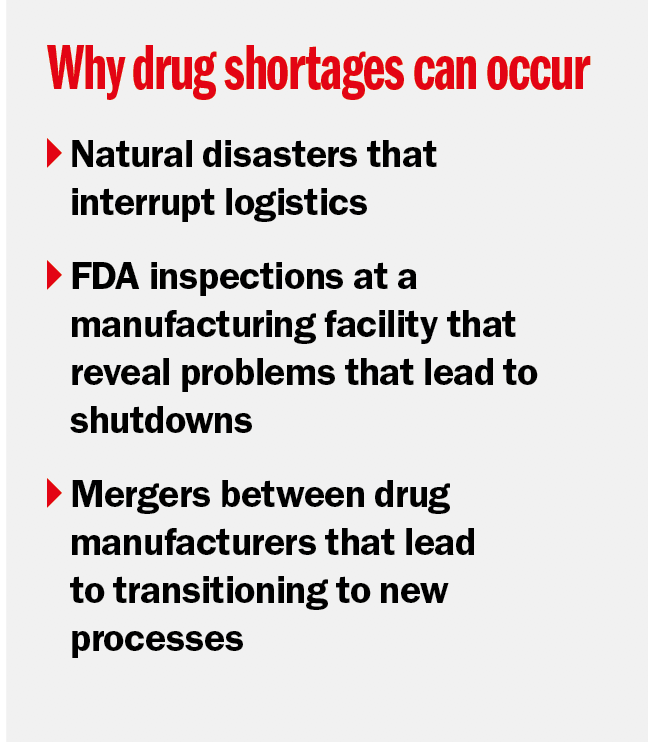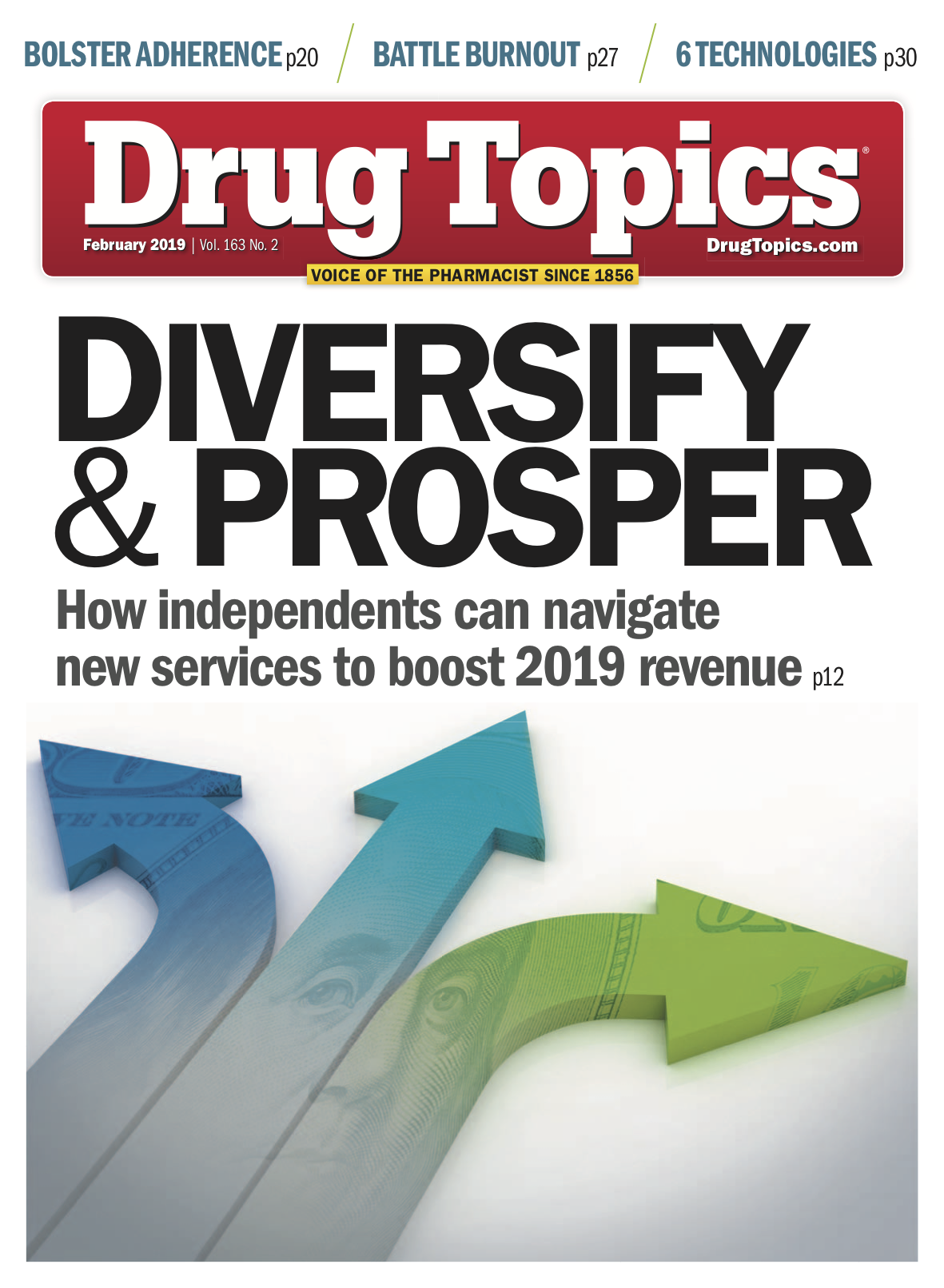How Hospital Pharmacists Are Dealing with Drug Shortages
Hospitals must consider operating mechanisms, educational updates, the behavior of prescribers, and even manufacturer transparency when surviving through drug shortages.

Why Drug Shortages Can Occur

Pain management is a struggle when pharmacists and prescribers are faced with drug shortages, says Shannon Manzi, PharmD, BCPPS, director of clinical pharmacogenomics services in the Division of Genetics and Genomics at Boston Children’s Hospital.
For example, she points to a situation where she and the pharmacists on her team had to map out the provision of opioid-based pain medications for surgical patients. Three of the options they had that were in short supply were hydromorphone, sufentanil, and fentanyl, based on each drug’s availability.
During the drug shortages, Manzi’s team collaborated with stakeholders from ICU units, anesthesia, the pain service, and operating room staff to determine which patients got hydromorphone after their surgeries and also determined which surgeries required the use of fentanyl or sufentanil. She says this changed from week to week as the availability of each of these medications fluctuated.
While these drug shortages are no longer an issue, Manzi learned some lessons she applies to current shortages. Those lessons also informed the tough questions she tackles regarding shortages.
These questions include:
- How much of this medication do we have on hand?
- How can we obtain more?
- How do we get it to the appropriate patients?
- How do we log it in the electronic health record (EHR) so it’s not orderable?
- How do we guide clinicians in the EHR to alternate medications and how to prescribe them?
Operating Mechanisms
Unforeseen events happen. That was the case after Hurricane Maria in September 2017, when access to medications, such as injectable opioids and certain IV fluids, were in short supply.
In response, Boston Children’s Hospital’s emergency management team organized the various stakeholders for weekly meetings to discuss the drugs currently on hand, the patients who could use other interventions, and strategies for minimizing nonessential use of those drugs in short supply, Manzi says. Some of these interventions included coordinating pharmacy-prepared IV fluids, encouraging enteral (oral use, sublingual use, or rectal administration) over parenteral (intramuscular, subcutaneous, or intravenous) medications, and changing delivery from IV bags to syringes where possible.
Still, making changes under duress is not the best way to introduce medication alternatives to doctors and nurses. These changes-whether they’re about different concentrations or ways of mixing a medication or administration-require changes to prescriber behavior; they also involve orchestrating changes in prescriber order entry, barcode medication administration, and smart pumps, all of which communicate with the EHR. And that’s time-consuming and complicated work, says Manzi.
What helps is a weekly meeting where Manzi and her team discuss the medications in short supply and develop a plan in response. On average, this takes about one hour to three hours a week, which doesn’t include the time it takes to implement those changes, she says. When Manzi’s team was in the thick of managing the shortages of opioid-based pain medications for surgery patients, it took five or six hours a week. Now that the most severe shortages have been alleviated, her team spends between one and two hours a week managing drug shortages.
Agility and Education Required
Joy Vreeland, PharmD, director of inpatient pharmacy at Boston Medical Center, says her pharmacists were given the task of figuring out how nurses were going to administer antibiotics when the availability of small IV fluid bags plummeted in October 2017 after Hurricane Maria.
Initially, the hospital’s nurses pivoted to administering antibiotics with syringes. After about two weeks, the availability of syringes also dipped, since other hospitals around the country were doing the same thing.
As an alternative, nurses at Boston Medical Center used IV push antibiotics with patients where appropriate, says Vreeland. This required nurses to mix antibiotics with sterile water and inject it for five minutes into the patient’s IV line, she says. Then the nurse would flush the IV line.
This isn’t the way nurses usually administer antibiotics, which meant many needed training. But there was a “silver lining,” she says. Nurses appreciated that they were able to spend more time with patients.
During the worst of the two months of shortages caused by the hurricane, Vreeland’s team was in crisis mode every day. All told, managing the crisis from a drug-access perspective stretched about 10 months, starting shortly after the hurricane hit until the following August.
Developing responses to shortages caused by Hurricane Maria was the most challenging pharmacy-related crisis Vreeland has worked on in 20 years, she says. Going forward, hospitals should be aware of the locations where drugs are manufactured. For example, if a drug is manufactured on an island in the hurricane belt, hospitals should have a back-up plan.
Prescriber Behavior
Collaborating with prescribers is the best way to determine appropriate alternatives when there are shortages, says Malia Manning, PharmD, manager of therapeutic policy/management at University of Alabama Hospital in Birmingham.
Manning works with the hospital’s pharmacy and therapeutics committee, which includes attending-level physicians across most specialties. It’s the physicians who determine the appropriate approaches for different patient populations when the hospital is faced with shortages.
The hospital develops a master list of drugs that are in shortage and makes it available to pharmacy staff and prescribers, says Manning. New drug shortages, restrictions, and status updates are sent by email each week to pharmacy staff, physicians on the pharmacy and therapeutics committee, and nursing leaders.
When a prescriber tries to order a restricted drug in the EHR, they’re alerted about the appropriate patient populations for the drug and alternatives for other patients. For example, if there’s a shortage of IV formulations, the oral formulation will be appropriate for many patients. The order is also verified by a pharmacist after the prescriber submits it, Manning says.
Manufacturer Transparency
Boston Medical Center’s Vreeland says doctors and nurses want to know why drugs aren’t available. Since she often doesn’t know the reason, she provides them with general reasons that drugs can be in short supply.
She laments the lack of transparency by drug manufacturers regarding supply chain issues that lead to shortages. The FDA could mandate more transparency from drug companies, she says.
While her team receives projected availability dates for drugs that are in shortage, often the timelines are very broad. For example, she may learn that a drug is projected to be available in Q2 next year. That broad timeline doesn’t give her the information she needs to plan around the drug shortage.
